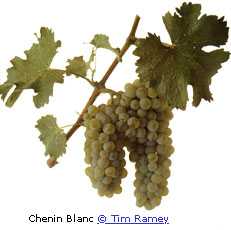Chenin Blanc Chenin Blanc is arguably the most versatile of all wine grape varieties. Crisp, dry table wines, light sparkling wines, long-lived, unctuous, nectar-like dessert wines, and brandy are all produced in various areas of the wine world, all of chenin blanc. It might even be said that Chenin Blanc is France's most successful export variety, if only considering the vine rather than the wine. Although the native region for Chenin Blanc is the Loire Valley (where the grape is often called Pineau de la Loire), there is less planted in all of France than in most wine-producing countries of the New World. It is planted as Pinot Blanco in Brazil, Chile, Mexico, and Argentina, where there are over 10,000 acres of chenin blanc. Nearly a third of vines in South Africa are Chenin Blanc, where it is also called Steen. In California, it is the third most widely planted white wine grape. Australia has close to 1,500 acres and New Zealand 500. |
||||||||||||
| The most frequently encountered (but not exclusive) smell and/or flavor elements found in Chenin Blanc-based wines include: | ||||||||||||
|
||||||||||||
| ©Jim LaMar, who is the editor of Professional Friends of Wine, promoting wine appreciation through knowledge. | ||||||||||||
 The vine grows well in many soil types and can be very vigorous in either sandy loam or clay loam. Chenin blanc grapes are susceptible to both bunch rot and sun burn.In spite of its wide plantings and potential flavor palates, most Chenin Blanc is made into serviceable, but generally bland wine. A general tendency to over-irrigate and overcrop further reduce most Chenin Blanc to the forgettable. Careful viticultural practices easily overcome chenin blanc's weaknesses and can result in excellent wine. No matter the style, a certain floral, honeyed character, along with zesty acidity are the sensory trademarks of well-made Chenin Blanc. When conditions are right, Botrytis cinerea adds additional complexity and intensity.Resistance to many diseases, vine vigor, and the tendency to early bud break and late ripening suits Chenin Blanc to grow in climates too warm for many vinifera types.
The vine grows well in many soil types and can be very vigorous in either sandy loam or clay loam. Chenin blanc grapes are susceptible to both bunch rot and sun burn.In spite of its wide plantings and potential flavor palates, most Chenin Blanc is made into serviceable, but generally bland wine. A general tendency to over-irrigate and overcrop further reduce most Chenin Blanc to the forgettable. Careful viticultural practices easily overcome chenin blanc's weaknesses and can result in excellent wine. No matter the style, a certain floral, honeyed character, along with zesty acidity are the sensory trademarks of well-made Chenin Blanc. When conditions are right, Botrytis cinerea adds additional complexity and intensity.Resistance to many diseases, vine vigor, and the tendency to early bud break and late ripening suits Chenin Blanc to grow in climates too warm for many vinifera types.